|
|
|






Mythology
is the study of myths and or of a body of myths. For example,
comparative mythology is the study of connections between myths from
different cultures, whereas Greek mythology is the body of myths from
ancient Greece. The term "myth" is often used colloquially to refer to
a false story; however, the academic use of the term generally does not
refer to truth or falsity. In the study of folklore, a myth is a sacred
narrative explaining how the world and humankind came to be in their
present form. Many scholars in other fields use the term "myth" in
somewhat different ways. In a very broad sense, the word can refer to
any traditional story. |

Alien or Aliens may refer to: foreign life, something of the non-earthly species. Extraterrestrial
life is defined as life which does not originate from planet Earth. The
existence of life outside the planet is theoretical and all assertions
of such life remain disputed. Hypotheses
regarding the origin(s) of extraterrestrial life, if it exists, are as
follows: one proposes that it may have emerged, independently, from
different places in the universe. An alternative hypothesis is
panspermia or exogenesis, which holds that life emerges from one
location, then spreads between habitable planets. These two hypotheses
are not mutually exclusive. The study and theorization of
extraterrestrial life is known as astrobiology, exobiology or
xenobiology. Speculated forms of extraterrestrial life range from life
with the simplicity of bacteria to sapient or sentient beings. Suggested
locations which might have once developed, or presently continue to
host life similar to our own, include the planets Venus and Mars, moons
of Jupiter and Saturn (e.g. Europa, Enceladus and Titan) and Gliese 581
c and d, recently discovered to be near Earth-mass extrasolar planets
apparently located in their star's habitable zone, and with the
potential to have liquid water. To
date, no credible evidence of extraterrestrial life has been discovered
which has been generally accepted by the mainstream scientific
community. All
other proposals, including beliefs that some UFOs are of
extraterrestrial origin (see extraterrestrial hypothesis) and claims of
alien abduction, are considered hypothetical by most scientists. UFO
sightings are sightings of unidentified flying objects that may or may
not be connected with extraterrestrial intelligent life. Most of these
sightings can be dismissed as sightings of Earth based aircraft or
known astronomical objects or perpetration of hoaxes. However some
sightings have gone unexplained, having been reported in some cases by
police and airline pilots. In
2006, New Scientist published a list of ten controversial pieces of
evidence that extraterrestrial life exists, but scientists do not
consider them credible since no direct observational evidence has been
encountered. However, many scientists, such as Carl Sagan, believe that
it is nearly impossible that no other intelligent life exists in the
universe. |
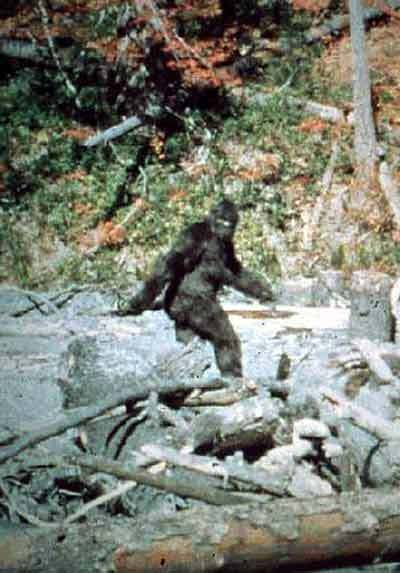
Bigfoot,
also known as Sasquatch, is an alleged ape-like creature purportedly
inhabiting forests, mainly in the Pacific Northwest region of North
America. Bigfoot is usually described as a large, hairy, bipedal
humanoid. The
scientific community considers Bigfoot to be a combination of folklore,
misidentification, and hoaxes, rather than a real creature. In general,
mainstream scientific consensus does not support the posited existence
of megafauna cryptids such as Bigfoot, because of the improbably large
numbers necessary to maintain a breeding population and because climate
and food supply issues would make such purported creatures' survival in
reported habitats unlikely. Despite these facts, Bigfoot is one of the
more famous examples of a cryptid within cryptozoology. |
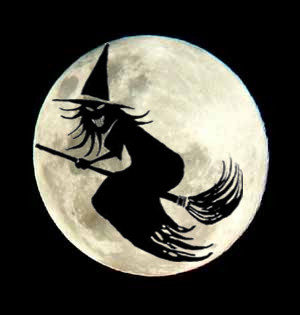
Witchcraft,
in various historical, anthropological, religious and mythological
contexts, is the use of certain kinds of supernatural or magical
powers. Witchcraft can refer to the use of such powers in order to
inflict harm or damage upon members of a community or their property.
Other uses of the term distinguish between bad witchcraft and good
witchcraft, the latter involving the use of these powers to heal
someone from bad witchcraft. The concept of witchcraft is normally
treated as a cultural ideology, a means of explaining human misfortune
by blaming it either on a supernatural entity or a known person in the
community. A witch (from Old English wicce f. / wicca m., also compare
hag) is a practitioner of witchcraft. Belief
in witchcraft, and by consequence witch-hunts, are found in many
cultures worldwide, today mostly in Sub-Saharan Africa (e.g. in the
witch smellers in Bantu culture), and historically notably in Early
Modern Europe, where witchcraft came to be seen as a vast diabolical
conspiracy against Christianity, and accusations of witchcraft led to
large-scale witch-hunts, especially in Germanic Europe. The
"witch-cult hypothesis", a controversial theory that European
witchcraft was a suppressed pagan religion, was popularised in the 19th
and early 20th centuries. Since the mid-20th century, Witchcraft has
become the self-designation of a branch of neopaganism, especially in
the Wicca tradition following Gerald Gardner, who claimed a religious
tradition of Witchcraft with pre-Christian roots. |
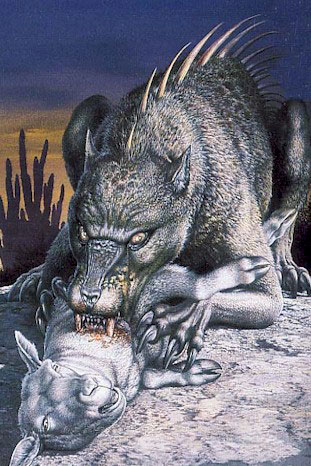
The
first reported attacks occurred in March 1995 in Puerto Rico. In this
attack, eight sheep were discovered dead, each with three puncture
wounds in the chest area and completely drained of blood. A few months
later, in August, an eyewitness, Madelyne Tolentino, reported seeing
the creature in the Puerto Rican town of Canóvanas, when as many as 150
farm animals and pets were reportedly killed. In 1975, similar killings
in the small town of Moca, were attributed to El Vampiro de Moca (The
Vampire of Moca). Initially it was suspected that the killings were
committed by a Satanic cult; later more killings were reported around
the island, and many farms reported loss of animal life. Each of the
animals had their bodies bled dry through a series of small circular
incisions. Puerto
Rican comedian and entrepreneur Silverio Pérez is credited with coining
the term chupacabras soon after the first incidents were reported in
the press. Shortly after the first reported incidents in Puerto Rico,
other animal deaths were reported in other countries, such as the
Dominican Republic, Argentina, Bolivia, Chile, Colombia, Honduras, El
Salvador, Nicaragua, Panama, Peru, Brazil, United States, and Mexico. |
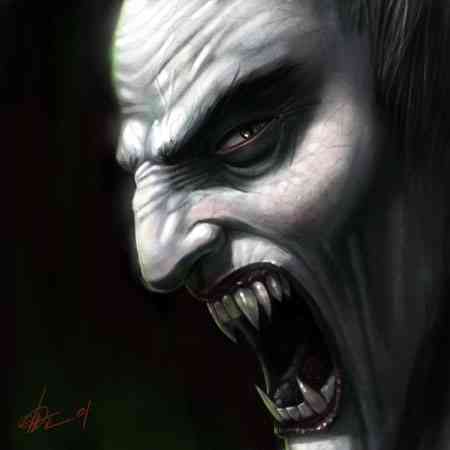
Vampires
are legendary creatures said to subsist by feeding on the life essence
of living creatures, generally by drinking their blood. Although
typically described as undead, some minor traditions believed in
vampires that were living people. In
folkloric tales, vampires often visited loved ones and caused mischief
or deaths in the neighbourhoods they inhabited when they were alive.
They wore shrouds and were often described as bloated and of ruddy or
dark countenance. This is markedly different from modern fictional
portrayals of gaunt, pale vampires beginning in the early 19th century.
Although vampiric entities have been recorded in many cultures, the
term vampire was not popularised until the early 18th century, after an
influx of vampire superstition into Western Europe from areas where
vampire legends were frequent, such as the Balkans and Eastern Europe,
although local variants were also known by different names, such as
vampir (??????) in Serbia and Bulgaria, vrykolakas in Greece and
strigoi in Romania. This increased level of vampire superstition in
Europe led to mass hysteria and in some cases resulted in corpses
actually being staked and people being accused of vampirism. In
modern times, the vampire is generally held to be a fictitious entity,
although belief in related creatures such as the chupacabra still
persists in some cultures. Early folkloric belief in vampires has been
ascribed to ignorance about the process of decomposition after death
among pre-industrial societies. Porphyria was also linked with legends
of vampirism in the 20th century and received much media exposure, but
this link has since been largely discredited. The
charismatic and sophisticated vampire of modern fiction was born in
1819 with the publication of The Vampyre by John Polidori. The story
was highly successful and arguably the most influential vampire work of
the early 19th century. However, it is Bram Stoker's 1897 novel Dracula
that is remembered as the quintessential vampire novel and which
provided the basis of modern vampire fiction. The success of this book
spawned a distinctive vampire genre, still popular in the 21st century,
with books, films, video games, and television shows. The vampire is a
dominant figure in the horror genre. |
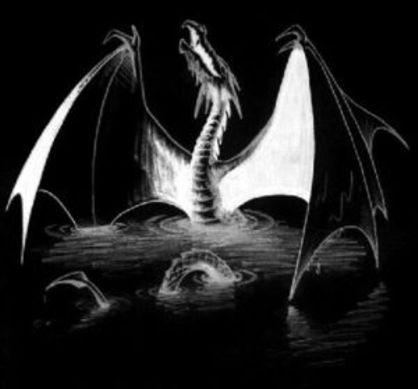
Dragons
are legendary creatures, typically with serpentine or otherwise
reptilian traits, that feature in the myths of worldwide cultures. The
two most familiar interpretations of dragons are European dragons,
derived from various European folk traditions, and the unrelated
Oriental dragons, such as the Chinese dragon (lóng ? or ?). The English
word "dragon" derives from Greek ?????? (drako-n), "dragon, serpent of
huge size, water-snake", which probably comes from the verb ???????
(drakein) "to see clearly". Dragons
are usually shown in modern times with a body like a huge lizard, or a
snake with two pairs of lizard-type legs, and able to emit fire from
their mouths. The European dragon has bat-type wings growing from its
back. A dragon-like creature with no front legs is known as a wyvern.
Following discovery of how pterosaurs walked on the ground, some
dragons have been portrayed without front legs and using the wings as
front legs pterosaur-fashion when on the ground, as in the movie Reign
of Fire. |
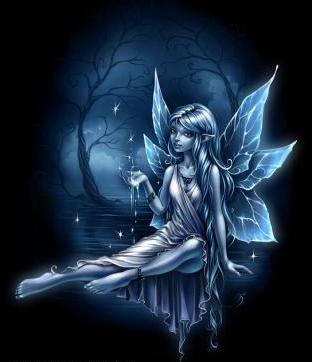
A
dwarf is a creature from Germanic mythologies, fairy tales, fantasy
fiction, and role-playing games. It usually has magical talents, often
involving metallurgy. The
original concept of dwarves is very difficult to determine. The sources
closest to the original Germanic mythology come from Norse Mythology,
but even these are scarce and varied. Sources have gradually given
dwarves more comical and superstitious roles. Dwarves were certainly
humanoid, but sources differ over their height, their lifestyles, and
their similarity to elves. Considering early sources, and considering
the dwarves' nature, original dwarves seem fully human height. They had
strong associations with death[2][3]: paled skin; dark hair;
connections with the earth; their role in mythology. They followed
animistic traditions, showing similarities to such concepts of the
dead. They were similar to others from the 'Vættir' family, such as
elves. As
their mythology evolved, the most notable changes have had them become
more comical and more mysterious. They adopted the modern image of
short height and ugliness. Their associations with the underground
became more predominant. Dwarves were magical creatures with huge skill
at metallurgy, taking fame for making great artifacts of legend. Late
Norse concepts of dwarves became quite different from the early ones.
The Legendary saga shows the new trend. The remnants of the original
dwarf formed later fairy tales and folklore (see German folklore, and
Dutch folklore). They had become unseen magical creatures like fairies;
users of charms, curses, and deceit. Modern
fantasy and literature have formed an intriguing web of concepts, from
that of the original dwarf, to the dwarf of later Norse mythology, the
dwarf of folk-tales, and of other mythology. The typical modern dwarf
has distinctive features such as short stature, excessive hair, and
skill at mining and metallurgy. However, modern literature draws from a
wide range, and dwarves vary in fidelity to historical notions. Many
fantasists devise new powers or images for dwarves. Modern dwarves have
no strict definition. The
conception of dwarves as short is probably the most tenacious, and the
term 'dwarf' can now describe short humans, regardless of its mythical
origins. The universal modern description of a dwarf is something
short, usually associated with magic, fantasy, and fairy tales. |
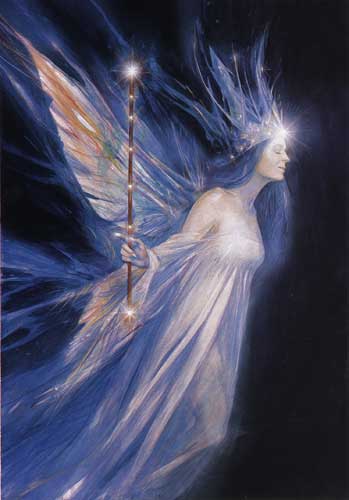
A
fairy (also fay, fey, faery, faerie; collectively, "fae", wee folk,
good folk, people of peace, fair folk, and other euphemisms) is a type
of mythological being or legendary creature, a form of spirit, often
described as metaphysical, supernatural or preternatural. The
word fairy derives from the term fae of medieval Western European (Old
French, from Latin fata: Fate) folklore and romance, one famous example
being Morgan le Fay ('Morgan of the Fae'). "Fae-ery" was therefore
everything that appertains to the "fae", and so the land of "fae", all
the "fae". Finally the word replaced its original and one could speak
of "a faery or fairy", though the word fey is still used as an
adjective or to refer to the word fairy as a plural. Fairies
resemble various beings of other mythologies, though even folklore that
uses the term fairy offers many definitions. Sometimes the term
describes any magical creature, including goblins or gnomes: at other
times, the term only describes a specific type of more ethereal
creature. |

A
ghost has been defined as the disembodied spirit or soul of a deceased
person, although in popular usage the term refers only to the
apparition of such a person. Often described as immaterial and partly
transparent, ghosts are reported to haunt particular locations or
people that they were associated with in life or at time of death. Phantom armies, ghost animals, ghost trains and phantom ships have also been reported. Ghosts or similar paranormal entities appear in film, theatre, literature, myths, legends, and some religions. Although
the human soul was sometimes symbolically or literally depicted in
ancient cultures as a bird or other animal, it was widely held that the
soul was an exact reproduction of the body in every feature, even down
to clothing the person wore. This is depicted in artwork from various
ancient cultures, including such works as the Egyptian Book of the
Dead, which shows deceased people in the afterlife appearing much as
they did before death, including the style of dress. |

A mermaid is a mythological aquatic creature with a human head and torso and the tail of an aquatic animal such as a fish. Claimed
sightings of dead or living mermaids have come from places such as Java
and British Columbia. There are two Canadian reports from the area of
Vancouver and Victoria, one from sometime between 1870 and 1890, the
other from 1967. In
August 2009, the town of Qiryat Yam in Israel offered a prize of US$1
million for anyone who could prove the existence of a mermaid off its
coast, after dozens of people reported seeing a mermaid leaping out of
the water like a dolphin and doing aerial tricks before returning to
the depths. During the Renaissance and Baroque eras, dugongs, frauds and victims of sirenomelia were exhibited in wunderkammers as mermaids. In
the 19th century, P. T. Barnum displayed in his museum a taxidermal
hoax called the Fiji mermaid. Others have perpetrated similar hoaxes,
which are usually papier-mâché fabrications or parts of deceased
creatures, usually monkeys and fish, stitched together for the
appearance of a grotesque mermaid. In the wake of the 2004 tsunami,
pictures of Fiji "mermaids" circulated on the Internet as supposed
examples of items that had washed up amid the devastation, though they
were no more real than Barnum's exhibit. |
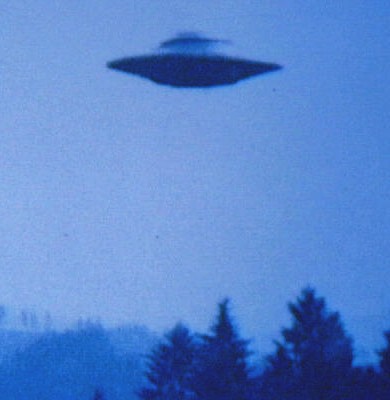
Unidentified
flying object (commonly abbreviated as UFO or U.F.O.) is the popular
term for any aerial phenomenon whose cause cannot be easily or
immediately identified. The United States Air Force, which coined the
term in 1952, initially defined UFOs as those objects that remain
unidentified after scrutiny by expert investigators, though the term
UFO is often used more generally to describe any sighting
unidentifiable to the reporting observer(s). Popular culture frequently
takes the term UFO as a synonym for alien spacecraft. Cults have become
associated with UFOs, and mythology and folklore have evolved around
the phenomenon. Some investigators now prefer to use the broader term
unidentified aerial phenomenon (or UAP), to avoid the confusion and
speculative associations that have become attached to UFO. Another
widely known acronym for UFO in Spanish, French, Portuguese and Italian
is OVNI. Studies
have established that the majority of UFOs are observations of some
real but conventional object—most commonly aircraft, balloons, or
astronomical objects such as meteors or bright planets—that have been
misidentified by the observer as anomalies while a small percentage of
reported UFOs are hoaxes. Only a small percentage of reported sightings
(usually 5 to 20%) can be classified as unidentified flying objects in
the strictest sense (see below for some studies). Some
scientists have argued that all UFO sightings are misidentifications of
natural phenomena and historically, there was debate among some
scientists about whether scientific investigation was warranted given
available empirical data. Very little peer-reviewed literature has been
published in which scientists have proposed, studied or supported
non-prosaic explanations for UFOs. Allen Hynek was a trained astronomer
who participated in Project Bluebook after doing research as a federal
government employee. He formed the opinion that some UFO reports could
not be scientifically explained. Through his founding of the Center for
UFO Studies and participation at CUFOs he spent the rest of his life
researching and documenting UFOs. The movie Close Encounters of the
Third Kind had a character loosely based on Hynek. Another group
studying UFOs is Mutual UFO Network. MUFON is a grass roots based
organization known for publishing one of the first UFO investigators
handbooks. This handbook went into great detail on how to document
alleged UFO sightings. UFO
reports became frequent after the first widely publicized U.S.
sighting, reported by private pilot Kenneth Arnold in 1947, that gave
rise to the popular terms "flying saucer" and "flying disc." Since
then, millions of people have reported that they have seen UFOs. |
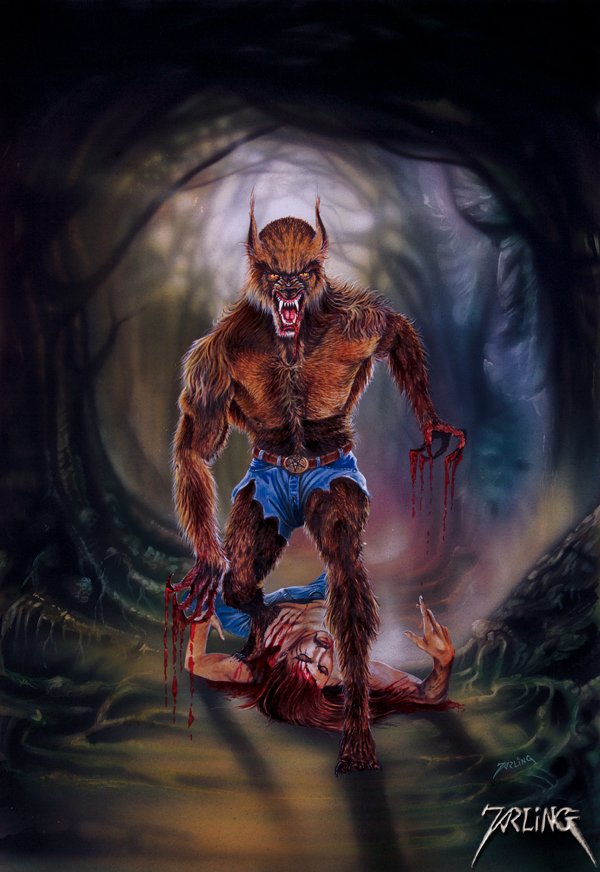
A werewolf or werwolf, also known as a lycanthrope (from the Greek λυκάνθρωπος: λύκος, lukos, "wolf", and άνθρωπος, anthrōpos, man), is a mythological or folkloric human with the ability to shapeshift into a wolf or an anthropomorphic wolf-like creature, either purposely, by being bitten or scratched by another werewolf, or after being placed under a curse. This transformation is often associated with the appearance of the full moon, as popularly noted by the medieval chronicler Gervase of Tilbury, although it may have been recognized in earlier times among the ancient Greeks through the writings of Petronius. Werewolves are often granted extra-human strength and senses, far beyond those of both wolves or men. The werewolf is generally held as a European character, although its lore spread through the world in later times. Shape-shifters, similar to werewolves, are common in tales from all over the world, most notably amongst the Native Americans, though most of them involve animal forms other than wolves. Werewolves are a frequent subject of modern fictional books, although fictional werewolves have been attributed traits distinct from those of original folklore, most notably the vulnerability to silver bullets. Werewolves continue to endure in modern culture and fiction, with books, films and television shows cementing the werewolf's stance as a dominant figure in horror. |

